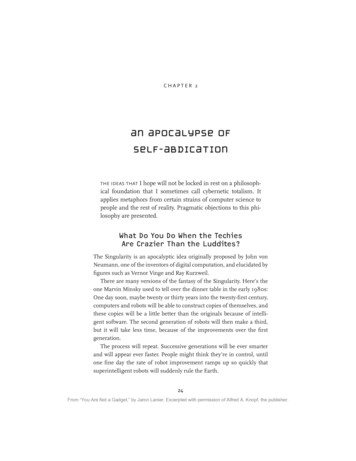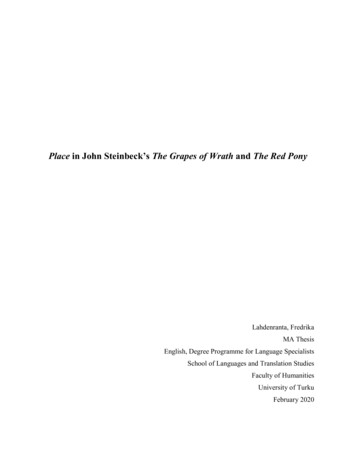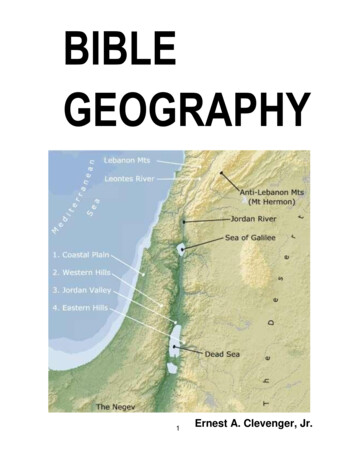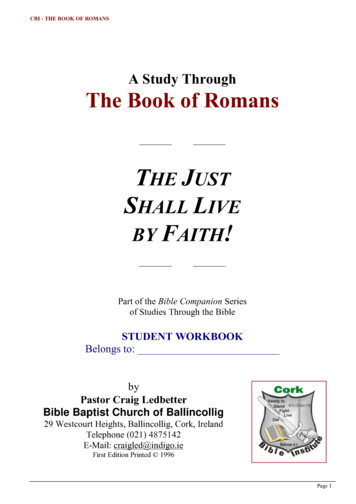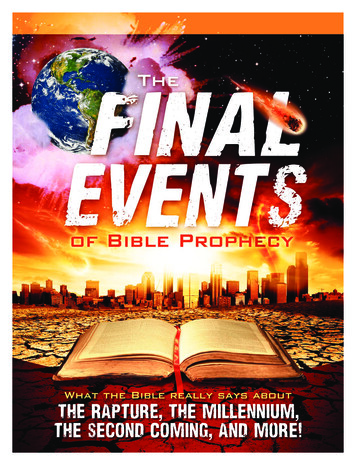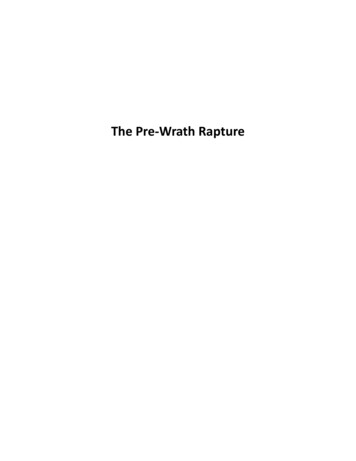
Transcription
The Pre-Wrath Rapture
A Brief Discussion of HermeneuticsLet's begin with a brief discussion of hermeneutics. What is a hermeneutic? Webster defines it as the study of the methods and principles of interpretation. As it applies to the Bible it is the study of how to understand theBible. Most of us would agree on some basic principles regarding hermeneutics.1) We should seek to understand the authors intended meaning. This issometimes called exegesis. Getting the meaning out of the text as opposedto eisegesis, putting meaning into the text. We want to discover the meaning of the text, not determine the meaning of the text and we do thatthrough things like context.2) All Scripture must be taken in its proper context. This means that the interpretation of Scripture should be looked at in light of the verse and bookin which the passage is found. The argument of the author and historicaland cultural context should be taken into account.3) Always compare scripture with other scripture. For example, If one isstudying the return of Christ in one instance, then one needs to comparepassages from Daniel Isaiah Ezekiel Zachariah Matthew First and 2 Thessalonians, 2 Peter, Jude, Revelation etc Only once all relevant passageshave been studied and compared can we be sure of our interpretation.4) Determine the literal references of figures of speech that provide comparison, substitution, and amplification. Scripture, like any serious literature,uses figures of speech. These include similes, metaphors, hyperbole, Idioms, and parallelisms. When the Bible wants you to allegorize or takesomething as a symbol it will make that clear in someway. For instance,words such as ‘like’ or, ‘as’, or ‘as it were’ are used. For instance, ‘as sackcloth made of hair’. Clearly that is poetic language yet it is intending to convey some literal truth. In that case it is that the sun will be darkened just assackcloth is also dark. Jesus spoke in parables but he was intending toconvey some literal truth.5) Recognize the near/far implications and applications of prophetic passages. It is common in prophetic literature to have a both near application
and far application to a certain prophecy. The letters to the seven churchesfor example in revelation were relevant to their immediate audience. Yetthese letters also mentioned the coming of Christ and are thus relevant tothe final generation that will be on earth when he returns. Another examplewould be the abomination of desolation. This was prefigured or fulfilled inthe time between the old and new Testaments with Antiochus Epiphanies.However, Christ said that we would see it again before his coming. Meaning there is another fulfillment of that prophecy as well.There are no contradictions.If you have a contradiction you have the wrong hermeneutic. Justin Martyronce said,‘Since I am entirely convinced that no scripture contradicts another Iwill rather acknowledge that I do not understand what is written.’The Pre-Wrath View of the RaptureThere have traditionally been three views of the rapture, pre, mid and posttrib. However in 2010 the second edition of "The Three Views on the Rapture" published by Zondervan did away with the second position, MidTribulation, and replaced it with pre-wrath. This shows that the pre-wrathposition is not some fly-by-night view but can be articulated and defendedfrom a scholarly perspective and that it has overtaken the mid tribulationview in many people's minds and I will suggest that it will ultimately end therapture debate altogether if it could be given a fair hearing. I think this is actually a good book for one particular reason. It explains the pre-wrath viewmore or less correctly. Unlike on the Internet where there seem to be manypeople claiming to critique the pre-wrath view who clearly don't appear toknow what the pre-wrath view teaches, which is one of the greatest obstacles to a true debate on this matter in my opinion. People are unaware ofwhat this view is actually saying.The book of Revelation gives us very vivid images of the wrath of God. Itis symbolized as a scroll. There are seals that are keeping the scroll frombeing opened. Revelation 5:2 says, “Who is worthy to break the seals andopen the scroll”. The answer is given "but one of the elders said to me 'do
not weep, behold, the lion of the tribe of Judah, the Root of David, has prevailed to open the scroll and to loose it's seven seals." Christ came the firsttime as a Suffering Servant, to be the Lamb of God that takes away thesins of the world. The next time he will come in judgment. After all who isworthy to judge but he who has no sin. Acts 7:31 says, “because he hasappointed a day on which he will judge the world in righteousness by theman whom he has ordained. He has given assurance of this to all by raising him from the dead.” I will make a case later on that the seals are not thejudgment itself, but only the contents of the scroll are considered God'swrath.In the last days the wrath of God will be played out during a specific timecalled the ‘Day of the Lord’. This day is referred to quite a lot in the oldand New Testament, in fact, about 70 times. It is a time period of longerthan one day so don't let that throw you off. The word for day is ‘Yom’ in theHebrew. It is used both ways in the text, which is always determined by thecontext. We know that the Day of the Lord in prophecy is at least longerthan five months because of the fifth trumpet which is part of the day theLord, and that's a plague that lasts about five months. So, the Day of theLord is at least that long, but for many reasons it is probably much longerthan that and Christians will be raptured before this time. Many passagesspeak of Day of the Lord as an unparalleled time God's wrath. Zephaniahsays,“Neither their silver nor their gold shall be able to deliver them In theday of the Lord's wrath; But the whole land shall be devoured by thefire of His jealousy, for He will make speedy riddance of all those whodwell in the land.” Zephaniah 1:18Isaiah says something interesting about the Day of the Lord as we progress. He says the loftiness of man shall be bowed down and the haughtiness of man shall be brought low. The Lord alone shall be exalted in thatday. In the New Testament John says that the Day of the Lord will be God'swrath in Revelation 6. It says "And say unto the mountains and rocks. Fallon us and hide us from the face of him who sits on the throne and from thewrath of the Lamb. For the great day of his wrath has come and who isable to stand". Peter has the same idea when he says "but the heavensand the earth which are now preserved by the same word are reserved for
fire until the day of judgment and perdition of ungodly men, but the Day ofthe Lord will come as a thief in the night in which the heavens shall passaway with a great noise and the elements will melt with fervent heat. Theearth and the works that are in it will be burned up.”The Promise of a SignBecause of the severity of the Day of the Lord God has promised to givethe world a sign that his wrath is about to begin. The book of Joel is almostentirely about the Day of the Lord and he says,“The sun shall be turned into darkness, And the moon into blood, Before the coming of the great and awesome day of the Lord.” Joel 2:31This is also repeated in the New Testament in the book of Acts when itsays,“The sun shall be turned into darkness, And the moon into blood, Before the coming of the great and awesome day of the Lord.” Acts 2:20When signs in the sun, moon, and stars are given everyone will be terrified. Everyone that is except the righteous people who look forward to thisday because it means that their redemption is drawing near. It says in Luke21,"And there will be signs in the sun, in the moon, and in the stars; andon the earth distress of nations, with perplexity, the sea and the wavesroaring; men's hearts failing them from fear and the expectation ofthose things which are coming on the earth, for the powers of theheavens will be shaken. Then they will see the Son of Man coming in acloud with power and great glory. Now when these things begin tohappen, look up and lift up your heads, because your redemptiondraws near.” 2 Peter 3:10-13Peter also instructs the Christians. He wrote to,
“But the day of the Lord will come as a thief in the night, in which theheavens will pass away with a great noise, and the elements will meltwith fervent heat; both the earth and the works that are in it will beburned up. Therefore, since all these things will be dissolved, whatmanner of persons ought you to be in holy conduct and godliness,looking for and hastening the coming of the day of God, because ofwhich the heavens will be dissolved, being on fire, and the elementswill melt with fervent heat? Nevertheless we, according to His promise,look for new heavens and a new earth in which righteousness dwells.”2 Peter 3:10-13In every case in scripture these signs, the sun and moon and stars warnthe world about the wrath that is about to come on the ungodly. We are toldthese things could be used for signs in Genesis 1. Then God said, "Letthere be lights in the firmament of heaven to divide the day from the nightand let them be for signs and seasons and for days and years."The Wrath of God or the Wrath of Satan?One of the most important things to understand is that the persecution ofChristians by the antichrist is not the wrath of God but instead the wrath ofSatan. In Revelation 12 it says, "Therefore rejoice O heavens and you thatdwell in them. Woe to the inhabitants of the earth and the sea for the devilhas come down to you having great wrath because he knows he has but ashort time and what does he do with that short time? He makes war againstthe saints and overcomes them. In Revelation 13:4 it says,“So they worshiped the dragon who gave authority to the beast; andthey worshiped the beast, saying, “Who is like the beast? Who is ableto make war with him?”And he was given a mouth speaking great things and blasphemies,and he was given authority to continue for forty- two months. Then heopened his mouth in blasphemy against God, to blaspheme His name,His tabernacle, and those who dwell in heaven. It was granted to him
to make war with the saints and to overcome them. And authority wasgiven him over every tribe, tongue, and nation.” Revelation 13:4-7Some important characteristics of the Day of the Lord and the wrath ofGod are that it is against the wicked and when it happens the Lord alonewill be exalted. Satan's wrath however seems to be just the opposite. According to the Scriptures it is against the righteous and, the Antichrist isexalted. Reading 2 Thessalonians 24,"who opposes and exalts himself above all that is called God or that isworshiped, so that he sits as God in the temple of God, showing himself that he is God.” 2 Thessalonians 2:4We also know that it is this event, sometimes called the abomination ofdesolation where the antichrist exalts himself, that the persecution of theChristians begins in full swing.Daniel, Matthew, and John in Revelation all tie his bold actions here in thetemple, the abomination of desolation, to the start of serious persecution ofChristians, but Christ says that this particular persecution will be cut shortfor the elects sake. Which we are going to get to shortly. God's wrath iswhat will bring Satan's wrath to an end. God will rescue his people from theAntichrist persecution and begin the day Lord, which we have discussed tobe a fairly long period of time and is represented by the trumpet judgmentsand the bowls wrath in the book of Revelation.The Rapture and The Day of the Lord- Back to Back EventsPaul says it this way when talking about God's wrath ending the persecution of the church. He says,“since it is a righteous thing with God to repay with tribulation thosewho trouble you, and to give you who are troubled rest with us whenthe Lord Jesus is revealed from heaven with His mighty angels, inflaming fire taking vengeance on those who do not know God, and on
those who do not obey the gospel of our Lord Jesus Christ.” 2 Thessalonians 1:6-8This verse, when we look closer at it's context, will help us to transition into something that I think is really important and something that the Churchof the New Testament, as well as the early church fathers, seemed to bewell aware of. That is, that the rapture and the Day of the Lord wereback-to-back events. It makes perfect sense if you think about it. We aretold that we are going to be raptured before God's wrath and the Day ofthe Lord is God's wrath. So it would stand to reason that soon after we areraptured the wrath would begin.This would also explain all the verses that tell Christians to look forward toand hasten the Day of the Lord. Or, as Luke puts it, “to lift up your head”,but yet in the same breath they speak of it as a punishment for the wicked.Paul says here, in 2 Thessalonians 1,“Since it is a righteous thing with God to repay with tribulation thosewho trouble you, and to give you who are troubled rest with us whenthe Lord Jesus is revealed from heaven with His mighty angels, inflaming fire taking vengeance on those who do not know God, and onthose who do not obey the gospel of our Lord Jesus Christ. Theseshall be punished with everlasting destruction from the presence of theLord and from the glory of His power, when He comes, in that Day, tobe glorified in His saints and to be admired among all those who believe, because our testimony among you was believed.” 2 Thessalonians 1:6-10Paul says that the repayment of the wicked will happen on the sameday of the churches glorification. Keep in mind that this is the beginningof the letter written by Paul to a church that he praises for their patient endurance through what seems to be brutal persecutions.Paul wrote this letter because they had apparently been taught that theyhad missed the rapture and were in the Day of the Lord because of theirtorments. This opening of the second letter to the Thessalonians is assuring them that the rapture is still a future event and that the rapture will infact deliver them from the tribulations when it does happen. As we will seeit is literally impossible to understand the next chapter, 2 Thessalonians 2,
one of the most debated versus in rapture history, unless you understandthat Paul believed and taught the Thessalonians that the rapture would initiate the Day of the Lord.Paul also interchanges the idea of the rapture and the Day of the Lord inthe most famous rapture verse ever, that is, 1 Thessalonians chapter 4.But, it often goes unnoticed because there is a chapter break right in themiddle of the chapter. Chapter 5 keeps right on going with the samethought. This says,“For the Lord Himself will descend from heaven with a shout, with thevoice of an archangel, and with the trumpet of God. And the dead inChrist will rise first. Then we who are alive and remain shall be caughtup together with them in the clouds to meet the Lord in the air. Andthus we shall always be with the Lord. ” 1 Thessalonians 4:16-17Then there is the chapter break. But, then it continues,“But concerning the times and the seasons, brethren, you have noneed that I should write to you.” 1 Thessalonians 5:1The subject of this whole passage never changed. They were always talking about the rapture. Paul simply refers to the rapture as the Day of theLord and we are going to see why he does that as we progress.Paul's theology in this regard is demonstrated in almost all of his letters.He says things like,"I have fought the good fight, I have finished the race, I have kept thefaith. Finally, there is laid up for me the crown of righteousness, whichthe Lord, the righteous Judge, will give to me on that Day, and not tome only but also to all who have loved His appearing.” 2 Timothy 4:78So Paul, who is about to be executed writes that he looks forward, as weall should, to that day. The "D" is capitalized in most translations as it isspeaking of the Day of the Lord. The word appearing here is a fairly rareword. It's used only six times in the New Testament and all of those byPaul. It's obvious he thinks it is the rapture. For instance,
"looking for the blessed hope and glorious appearing of our great Godand Savior Jesus Christ,.” Titus 2:13Keeping consistent with his theology he also uses the word to refer to theDay the Lord that will begin to destroy the antichrist he says,“And then the lawless one will be revealed, whom the Lord will consume with the breath of His mouth and destroy with the brightness ofHis coming.” 2 Thessalonians 2:8Like the Days of Noah and LotThis idea of deliverance of the righteous and the beginning to judge thewicked on the same day is also taught explicitly by Jesus and that's probably the reason that Paul is teaching it also.“Then He said to the disciples, “ The days will come when you will desire to see one of the days of the Son of Man, and you will not see it.”Luke 17:22and,“And as it was in the days of Noah, so it will be also in the days of theSon of Man: They ate, they drank, they married wives, they were givenin marriage, until the day that Noah entered the ark, and the floodcame and destroyed them all. Likewise as it was also in the days ofLot: They ate, they drank, they bought, they sold, they planted, theybuilt; but on the day that Lot went out of Sodom it rained fire and brimstone from heaven and destroyed them all. Even so will it be in the daywhen the Son of Man is revealed.” Luke 17:26-30So Jesus says that his return will be like the days of Noah. God will deliverhis faithful and on the same day begin the destruction of the wicked. Thereare some who try to say that Noah went into the ark seven days before therain started. They do this by interpreting a verse in the first part of Genesis7 in a particular way. They do this because it would fit a model of thechurch being protected, or raptured, seven years before the wrath or rainbegins. It would be really interesting if it were true. The problem is that later
on in the same chapter it explicitly states that they entered the ark on theexact same day that the rain began. It says,“In the six hundredth year of Noah's life, in the second month, the seventeenth day of the month, on that day all the fountains of the greatdeep were broken up, and the windows of heaven were opened. Andthe rain was on the earth forty days and forty nights. On the very sameday Noah and Noah's sons, Shem, Ham, and Japheth, and Noah'swife and the three wives of his sons with them, entered the ark.” Genesis 7:11-13Not to mention that holding to this interpretation, that they entered the arkseven days before the rain began, makes Jesus wrong, as well, in Luke 17.When he says,“They ate, they drank, they married wives, they were given in marriage, until the day that Noah entered the ark, and the flood came anddestroyed them all.” Luke 17:27So they entered the ark, salvation of the righteous, floods came, destruction of the wicked, all on the same day. It's all over scripture as Jesus mentions the same thing with Lot and Sodom and Gomorrah in the same passage just to make this point clear.So why am I spending so much time with this issue of the back-to-backnature of the rapture and the Day of the Lord? The reason is because understanding it will help to solve the rapture debate and number 2, there aremany people who, in an effort to keep the church out of any persecution,deny this is true. We will see why they do this later on.The Ghost Doctrine of ImminenceLet's talk about the doctrine of Imminence. This is held by pretribulationists, it is the idea that no events, prophetic or otherwise, need tooccur before the rapture happens. In other words, it could have occurred atany moment in the last 2000 years. This is contrasted with the many eventsthat must proceed the Day of the Lord. For instance, Joel says that the sun
moon and star signs must happen before the Day of the Lord. Also, Malachi says,"Behold, I will send you Elijah the prophet before the coming of thegreat and dreadful day of the Lord." Malachi 4:5Israel must be a nation and thus, back in their land. The apostasia, or falling away, must happen. The man of sin must declare himself to be God inthe temple according to Thessalonians and Matthew 24. Thus, if the rapture and the Day of the Lord are back-to-back events, the rapture could nothave happened for the last 2000 years. Many verses are used in defenseof this theory like Titus 2:13 which says,“We are those who are looking for that blessed hope and the gloriousappearing of the great God and our Savior Jesus Christ.” Titus 2:13Here is a list of the Greek words and all the proof text used in support ofimminence and other things like looking for, and waiting for, waits for, expects, alert or awake, alert, await, near or at hand. None of them have themeaning that “nothing” needs to happen before an event can take place. Infact, without a single exception, of every Greek word in every proof text regarding this issue not a single one of them carry the meaning that “no”events need to precede Christ’s coming. In fact, all of the words, save one,are dealing with the believer’s attitude concerning his coming. Not the timing of it at all. This attitude should be defined as expectancy not imminence.This is why some people term this the "Phantom doctrine". But, I don'twant to prejudice you against this term because there is a time period inwhich the Lord's return will be imminent. Although, only after certain eventstake place first, and after they do, it will be imminent.Some Pre-tribulationists appeal to the early church writings because itseems that many of them believed the rapture to be imminent in their lifetimes. That was true for some of them. But, if you look even closer you willsee that they also believed that the Antichrist was already on the scene.Whether it was a Roman Emperor or a pope, they believed that the persecution they were enduring was the persecution of the antichrist.It was never taught that the rapture could come before the antichrist untilthe 1800s. Larry Crutchfield, a professor at Columbia seminary, and a pre-
tribulationist, is an expert on the early church fathers. He wrote a papercalled "Rudiments of Dispensationalism in the Anti-Nicean Period". He waslooking for pretribulationalism in the early church fathers. But, he has this tosay, “While there are in the writings of the early church fathers seeds fromwhich the doctrine of the pre-tribulation rapture could be developed. It is difficult to find in them an unequivocal statement of the type of immanencyusually believed by pre-tribulationists.”Thomas Ice of the Pretrib Research Center quotes Crutchfield in his article, "The History of the Doctrine of the Rapture" as his evidence of a beliefin an imminent return of Christ in the early church. And he said patristicscholar, Larry Crutchfield, argues that the early church fathers believed inwhat he calls imminent intra-tribulationalism. That is, they believed thatthey were in the great tribulation but not the Day of the Lord. He summarizes the views of the pre-tribulation scholars on the issue as follows. With fewexceptions the pre-millennial fathers of the early church believed that theywere living in the last times. Thus they looked daily for the Lord's imminentreturn. Disbelief in the imminent return of Jesus Christ within the context ofongoing persecution has prompted us to broadly label the views of the earliest fathers imminent intra-tribulationalism.Tribulation For Believers or Not?The early church was holding to a more biblical view. We find in Revelation chapter 6 that the only thing that is preventing the beginning of God’sjudgment of the earth is the number of martyrs to be completed.“And they cried with a loud voice, saying, “How long, O Lord, holy andtrue, until You judge and avenge our blood on those who dwell on theearth?” Then a white robe was given to each of them; and it was saidto them that they should rest a little while longer, until both the numberof their fellow servants and their brethren, who would be killed as theywere, was completed.” Revelation 6:10-11A really good example of this is in Matthew 24 where we see this passage.“Immediately after the tribulation of those days the sun will be darkened, and the moon will not give its light; the stars will fall from heav-
en, and the powers of the heavens will be shaken. Then the sign of theSon of Man will appear in heaven, and then all the tribes of the earthwill mourn, and they will see the Son of Man coming on the clouds ofheaven with power and great glory. And He will send His angels with agreat sound of a trumpet, and they will gather together His elect fromthe four winds, from one end of heaven to the other.” Matthew 24:2931There is so much confusion about this verse and the reason is becausewe have defined this word tribulation incorrectly as the wrath of God. If wedo that we have to pretend this verse isn't talking about the rapture eventhough it's a mirror image of the famous verse in 1 Thessalonians chapter4, as we will see. But, if we simply look at how the Greek word "thlipsis" isused in the New Testament we will see that it is used of affliction or persecution. This is talking about a great affliction being cut short by the rapture.For example, almost every instance of this "thlipsis" in the New Testament is promising believers they will go through it. As in Mark 4 verses 16and 17. Where it says,“These likewise are the ones sown on stony ground who, when theyhear the word, immediately receive it with gladness; and they have noroot in themselves, and so endure only for a time. Afterward, whentribulation or persecution arises for the word's sake, immediately theystumble.” Mark 4:16-17Or,“These things I have spoken to you, that in Me you may have peace.In the world you will have tribulation; but be of good cheer, I haveovercome the world.” John 16:33Or,“strengthening the souls of the disciples, exhorting them to continue inthe faith, and saying, “We must through many tribulations enter thekingdom of God.” Acts 14:22And saying,“ We must through many tribulations enter the kingdom of God.”And there are many more verses such as,
“knowing that tribulation produces perseverance;” Romans 5:3Or“Who shall separate us from the love of Christ? Shall tribulation, or distress, or persecution, or famine, or nakedness, or peril, or sword?”Romans 8:35And also,“ rejoicing in hope, patient in tribulation.” Romans 12:12We are not going to go through the wrath of God. But, to say that weare not going to go through "thlipsis" is quite simply unbiblical. So, yes,there will be great tribulation, a great "thlipsis". It is the persecution by theantichrist that Christ describes. But, we are promised that we will be raptured out from the midst of it just before the Day of the Lord and then thewrath of God against the wicked will begin.So, before moving on, let's recap some of the basics.The wrath of God is poured out on the Day of the Lord.God alone, not the antichrist, will be exalted on that day.The Day of the Lord is a long period of time, at least five months but probably longer.The Sun, Moon, and Star sign will precede the Day of the Lord.The rapture and the Day of the Lord are back-to-back events,Imminence is not able to be found in Scripture or the early church.Matthew 24 is by far the most critical passage concerning the timing of therapture. It connects the book of Daniel to the book of Revelation and it fillsin the gap that will solve the rapture puzzle. But, because Matthew 24 describes the persecution of the church before the rapture many people havehad to throw away Matthew 24 to avoid that conclusion. Claiming that itwas not meant to instruct the church for reasons we will discuss at lengthlater on. But, because of this, we are left with an incomplete picture of theend times and hence the reason for the current Rapture debate.There is one aspect of the debate, about Matthew 24's relevance to thechurch, which I do feel we should hit before we begin, as it is so crucial to
the rest of the discussion. That is, that when Christ tells his disciples inMatthew 24 of the events leading up to this coming He ends that chronology with a description of the rapture. However, because of the implications ifthat is true, namely, that Christians would endure persecution, PreTribulationists have argued that these verses cannot be talking about therapture but instead about Armageddon, which is one of the last events thattakes place before the Millennium. I will show you why this is an unenviableposition to argue. First let's look at verse 30 and 31 in Matthew 24,“ they will see the Son of Man coming on the clouds of heaven withpower and great glory. And He will send His angels with a great soundof a trumpet, and they will gather together His elect from the fourwinds, from one end of heaven to the other.” Matthew 24:30-31Now let's compare it to 1 Thessalonians 4 which is regarded by everyone,know matter what your view of the rapture is, as the most descriptive viewof the rapture. It says,"For this we say to you by the word of the Lord, that we who are aliveand remain until the coming of the Lord will by no means precedethose who are asleep. For the Lord Himself will descend from heavenwith a shout, with the voice of an archangel, and with the trumpet ofGod. And the dead in Christ will rise first. Then we who are alive andremain shall be caught up together with them in the clouds to meet theLord in the air. And thus we shall always be with the Lord. Thereforecomfort one another with these words.” 1 Thessalonians 4:15-18Cooper ChartWe see from this chart put together by Charles Cooper in his book, "God'sElect in the Great Tribulation", that Matthew 24 verses 29 to 31 have morein common with 1 Thessalonians 4:13-18 than any other passage that isconsidered to be a rap
ing there is another fulfillment of that prophecy as well. There are no contradictions. If you have a contradiction you have the wrong hermeneutic. Justin Martyr once said, 'Since I am entirely convinced that no scripture contradicts another I will rather acknowledge that I do not understand what is written.' The Pre-Wrath View of the Rapture

